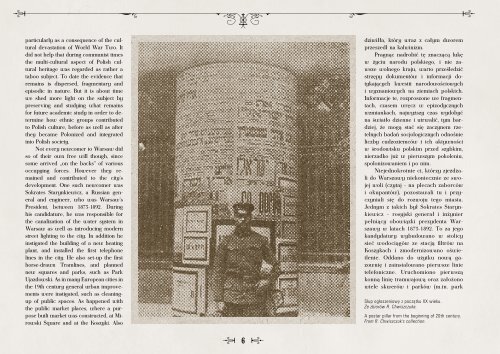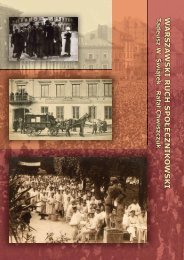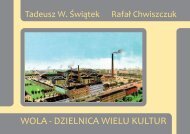You also want an ePaper? Increase the reach of your titles
YUMPU automatically turns print PDFs into web optimized ePapers that Google loves.
particularly as a consequence of the cultural<br />
devastation of World War Two. It<br />
did not help that during communist times<br />
the multi-cultural aspect of Polish cultural<br />
heritage was regarded as rather a<br />
taboo subject. To date the evidence that<br />
remains is dispersed, fragmentary and<br />
episodic in nature. But it is about time<br />
we shed more light on the subject by<br />
preserving and studying what remains<br />
for future academic study in order to determine<br />
how ethnic groups contributed<br />
to Polish culture, before as well as after<br />
they became Polonized and integrated<br />
into Polish society.<br />
Not every newcomer to Warsaw did<br />
so of their own free will though, since<br />
some arrived „on the backs” of various<br />
occupying forces. However they remained<br />
and contributed to the city’s<br />
development. One such newcomer was<br />
Sokrates Starynkiewicz, a Russian general<br />
and engineer, who was Warsaw’s<br />
President, between 1875-1892. During<br />
his candidature, he was responsible for<br />
the canalization of the water system in<br />
Warsaw as well as introducing modern<br />
street lighting to the city. In addition he<br />
instigated the building of a new heating<br />
plant, and installed the fi rst telephone<br />
lines in the city. He also set-up the fi rst<br />
horse-drawn Tramlines, and planned<br />
new squares and parks, such as Park<br />
Ujazdowski. As in many European cities in<br />
the 19th century general urban improvements<br />
were instigated, such as cleaningup<br />
of public spaces. As happened with<br />
the public market places, where a purpose<br />
built market was constructed, at Mirowski<br />
Square and at the Koszyki. Also<br />
6<br />
dziwiłła, który wraz z całym dworem<br />
przeszedł na kalwinizm.<br />
Pragnąc nadrobić tę znaczącą lukę<br />
w życiu narodu polskiego, i nie zawsze<br />
wolnego kraju, warto prześledzić<br />
strzępy dokumentów i informacji dotykających<br />
kwestii narodowościowych<br />
i wyznaniowych na ziemiach polskich.<br />
Informacje te, rozproszone we fragmentach,<br />
czasem wręcz w epizodycznych<br />
wzmiankach, najwyższy czas wydobyć<br />
na światło dzienne i utrwalić, tym bardziej,<br />
że mogą stać się zaczynem rzetelnych<br />
badań socjologicznych odnośnie<br />
liczby cudzoziemców i ich aktywności<br />
w środowisku polskim przed szybkim,<br />
nierzadko już w pierwszym pokoleniu,<br />
spolonizowaniem i po nim.<br />
Niejednokrotnie ci, którzy zjeżdżali<br />
do Warszawy niekoniecznie ze swojej<br />
woli (czytaj – na plecach zaborców<br />
i okupantów), pozostawali tu i przyczyniali<br />
się do rozwoju tego miasta.<br />
Jednym z takich był Sokrates Starynkiewicz<br />
– rosyjski generał i inżynier<br />
pełniący obowiązki prezydenta Warszawy<br />
w latach 1875-1892. To za jego<br />
kandydatury wybudowano w stolicy<br />
sieć wodociągów ze stacją fi ltrów na<br />
Koszykach i zmodernizowano oświetlenie.<br />
Oddano do użytku nową gazownię<br />
i zainstalowano pierwsze linie<br />
telefoniczne. Uruchomiono pierwszą<br />
konną linię tramwajową oraz założono<br />
wiele skwerów i parków (m.in. park<br />
Słup ogłoszeniowy z początku XX wieku.<br />
Ze zbiorów R. Chwiszczuka.<br />
A poster pillar from the beginning of 20th century.<br />
From R. Chwiszczuk's collection.




